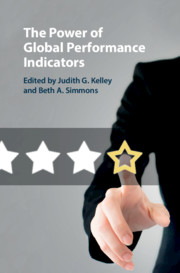Book contents
- The Power of Global Performance Indicators
- The Power of Global Performance Indicators
- Copyright page
- Contents
- Figures
- Tables
- Contributors
- Preface
- 1 Introduction
- Part I Ratings, Rankings, and Regulatory Behavior
- Part II The Normative Influence of Ratings and Rankings
- 5 A Race to the Top? The Aid Transparency Index and the Social Power of Global Performance Indicators
- 6 International Assessments and Education Policy
- 7 Reporting Matters
- 8 Freedom House’s Scarlet Letter
- Part III Beyond and Within State
- Part IV Skeptical Voices
- Index
- Chapter 3: Appendices
- Chapter 4: Appendices
- Chapter 5: Appendix
- Chapter 6: Appendix
- Chapter 7: Appendix
- Chapter 8: Appendix
- Chapter 10: Appendix
- Chapter 11: Appendix
- Chapter 12: Appendix
- References
8 - Freedom House’s Scarlet Letter
Assessment Power through Transnational Pressure
from Part II - The Normative Influence of Ratings and Rankings
Published online by Cambridge University Press: 28 February 2020
- The Power of Global Performance Indicators
- The Power of Global Performance Indicators
- Copyright page
- Contents
- Figures
- Tables
- Contributors
- Preface
- 1 Introduction
- Part I Ratings, Rankings, and Regulatory Behavior
- Part II The Normative Influence of Ratings and Rankings
- 5 A Race to the Top? The Aid Transparency Index and the Social Power of Global Performance Indicators
- 6 International Assessments and Education Policy
- 7 Reporting Matters
- 8 Freedom House’s Scarlet Letter
- Part III Beyond and Within State
- Part IV Skeptical Voices
- Index
- Chapter 3: Appendices
- Chapter 4: Appendices
- Chapter 5: Appendix
- Chapter 6: Appendix
- Chapter 7: Appendix
- Chapter 8: Appendix
- Chapter 10: Appendix
- Chapter 11: Appendix
- Chapter 12: Appendix
- References
Summary
Global Performance Indicators (GPIs) are a growing phenomenon in international politics, yet their influence remains difficult to measure and the mechanisms at work have been challenging to pin down. How do GPIs exert power over states in the international system and what are the consequences of that power? We argue that one of the pathways of GPI influence is through harnessing transnational pressure against poorly performing states. This article provides empirical evidence of that mechanism at work. We show that when a state receives a negative assessment in Freedom House’s annual Freedom in the World report, it is treated systematically worse by other states in a phenomenon we term the “Scarlet Letter effect.” A state branded “Not Free” by Freedom House receives increased verbal criticism from norm-respecting democracies, especially in the months immediately following the annual release of the Freedom in the World report. We separate the effect of Freedom House’s indicator itself from the effect of the underlying factors Freedom House measures by exploiting a discontinuity in the assignment of a country’s freedom status, whereby countries on either side of a bright-line receive different labels even though their level of political and civil liberty is similar. Additionally, our quantitative tests are supported by discussions with senior officials at Freedom House as well as organizations that make use of Freedom House’s scores when making or advising policy. We find that Freedom House’s annual indicator helps shape international discourse and diplomatic relations between states – fundamental aspects of international relations.
- Type
- Chapter
- Information
- The Power of Global Performance Indicators , pp. 242 - 268Publisher: Cambridge University PressPrint publication year: 2020
References
- 4
- Cited by



